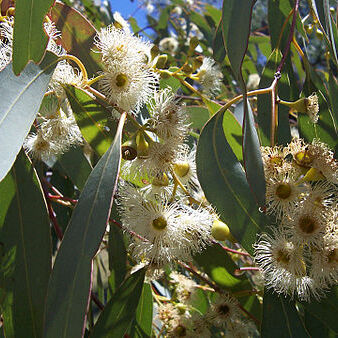Tree to 30 m high. Bark fibrous on lower trunk only or up to larger branches, grey, yellow or red-brown, then smooth, white-yellow above. Juvenile leaves alternate, petiolate, ovate or elliptic, grey-green, concolorous. Adult leaves narrowly lanceolate to lanceolate, acuminate; lamina 6.5–14 cm long, 0.8–1.8 cm wide, green or grey-green; lateral veins clearly visible, at 20°–40°; intramarginal vein up to 2 mm from margin; petiole terete or slightly flattened, 10–15 mm long. Umbels 7-flowered; peduncle terete or quadrangular, 3–11 mm long; pedicels 2–9 mm long. Buds clavate to fusiform; operculum conical to rostrate, usually narrower than hypanthium, 2–3 mm long, c. 3 mm wide; hypanthium hemispherical, 3–4 mm long and wide. Fruits hemispherical, ovoid to subglobular, 4–7 mm long and wide; valves usually 5, level or included.
Tree to 30 m with grey, yellow or red-brown fibrous bark on lower trunk and sometimes larger branches, yellowish white and smooth above.. Juvenile leaves ovate or elliptic; adult lanceolate, 6.5–14 cm long, 0.8–1.8 cm wide; petiole terete or slightly flattened, 1–1.5 cm long.. Umbels 7-flowered; peduncle terete or quadrangular, 0.3–1.1[1.5] cm long; pedicels 2–9 mm long.. Buds clavate to fusiform; operculum conical to rostrate, 2–3 mm long, ± 3 mm wide, usually narrower than the hemispherical calyx-tube which is 3–4 mm long and wide.. Fruits hemispherical, ovoid to subglobular, 4–7 mm long and wide with narrow descending disc and obscured by a prominent dark staminal ring and usually 5 flush or included valves.. Fig. 8/23, p. 41.


